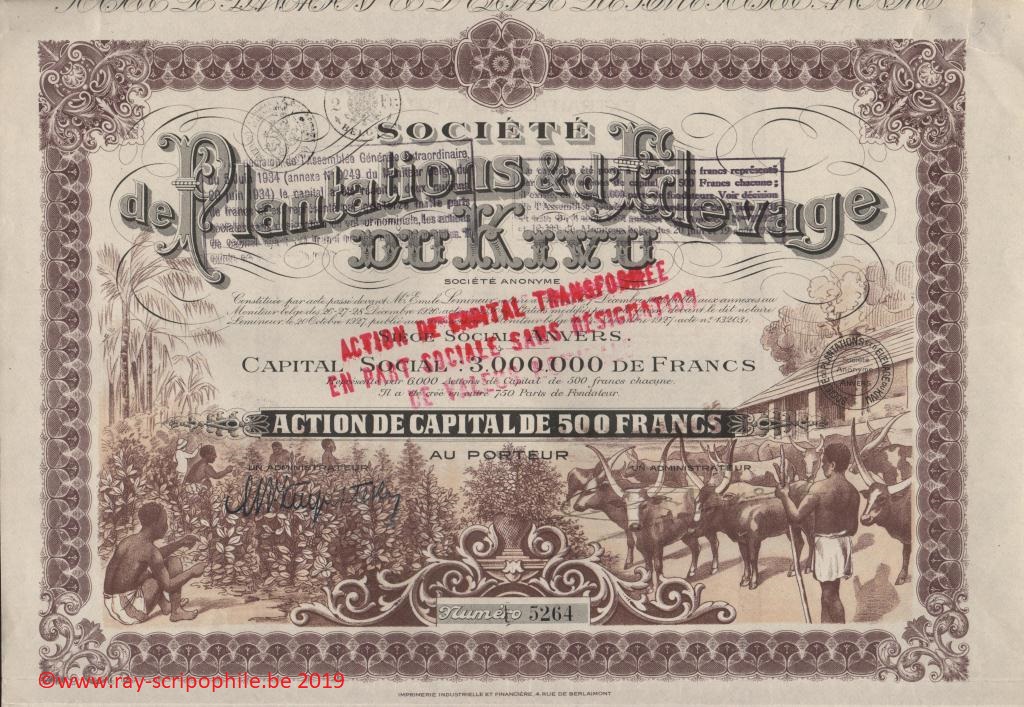Société de Plantations & d'Elevage du Kivu S.A.
Constitution
Contribution(s)
Mr. André Capart, planter, residing in Roubaix, contributed to the Company the right of occupation for five years, in view of the conclusion of a 30-year emphyteutic lease, granted by the Government of Belgian Congo, on 347 hectares of land, located in Nya-Birehe, with all the plantations, including a nursery of 200,000 coffee trees.
Board of Directors 1927
Object
Change(s) in capital
On December 6, 1927, the EGM decided to increase the capital to 3 million francs by creating 5,000 shares with a capital of 500 francs subscribed in cash; 250 founder's shares were created and allocated to subscribers on the basis of one share for every 20 shares subscribed.
The 5,000 paid-up capital shares of 50% were subscribed by:
Count Maximilien de Renesse-Breidbach, 250 shares; François Diels, 2,550 shares; Henri Jacqmain, 100 shares; H. Janssens-Foulon, 80 shares; Camille Pelgrins et Fils, 100 shares; Charles Vandewynckele, 1,000 shares; Joseph Wagemans, 920 shares (30-(1928 P 390 à 393).
On June 2, 1931, the capital was increased to 7 million francs by the creation of 8,000 new shares of 500 francs, with pro rata dividends, subscribed at par on August 4, 1931 by the Compagnie du Kivu, with the proviso that they be offered for retrocession at the same price to holders of old capital shares and founder's shares, as of right, in proportion to their shares and in accordance with the terms of the period to be determined. On the same date, the 115 founder's shares originally allocated to Mr. Henri Capart were cancelled outright and 365 new founder's shares were issued to Compagnie du Kivu in consideration for his underwriting of the capital increase, bringing the number of shares to 1,000 (maximum authorized) (21-(1935 T3)-239 to 241).
On June 5, 1934, the capital was reduced by 5 million francs and reduced from 7 to 2 million francs, the amount of this reduction to be allocated to the total amortization of losses for the 1933 financial year and the balance to the constitution of a forecast fund for amortization on fixed assets. The 14,000 existing shares with a capital of BEF 500 were converted into 14,000 shares with no par value (21-(1935 T3)-239 to 241).
Participation(s)
1928 - The Society participated in the constitution of the Comité National du Kivu by taking a 500,000 BEF share in this body (21-(1935 T3)-239 to 241).
1929 - In its capacity as shareholder of the Comité National du Kivu, the Company participated in the constitution of the Société Immobilière du Kivu, with a capital of 100 million francs, by taking 104 shares of 500 francs each, 20% paid up; it also received 13 founder's shares free of charge (21-(1930 T3)-1066).
Event(s)
1930 - It operated its coffee plantations, cattle breeding, food crops and farmyard. At the end of the 1930 season, it recorded its first coffee harvest. In the same year, the backyard was severely affected by an epidemic that spread to the Kahundu region (21-(1930 T3)-1066).
1931 to 1933 - Following the economic crisis in the Belgian Congo, the Company had to restrict the scope of its "breeding" activity to better promote the expansion of its Arabica coffee plantations. In 1933, the Company had to decide to abandon the breeding activity due to the lack of interesting outlets. Its main activity became its Arabica coffee plantations (21-(1935 T3)-239 to 241).
1934 - The EGM rejected the liquidation for loss of more than half of the capital and decided to reduce the capital (see above). The Company continued to operate under a new program with the expectation of interesting results; expenses were reduced and reduced to the strict minimum to carry out the retained activities (21(1935 T3)-239 to 241).
1935 - The new program remained unchanged and the Council endeavored to continue implementation without losing sight of the imperative need to further reduce overhead costs. Serious work remained to be carried out if the Company wanted to obtain a remunerative return from the plantations; as the financial means were completely lacking, the parent Company, the Compagnie du Kivu, assisted in their execution. The Council studied a project of financial reorganization (21-(1936 T3)-18).
1936 - The extension of the coffee plantations was actively pushed; it had an area of about 265 hectares. One of the plantations was affected by flower abortion, but the treatment with pyrethrin, which was made compulsory, stopped this disease, so that serious damage was avoided. The Society's program provided for the establishment of new coffee plantations to the extent of all fertile land suitable for growing coffee. The various expenses incurred could only be met with the financial assistance of the Compagnie du Kivu, and as a result, the debt to the Company was further increased. The reorganization project studied in 1935 was continued with the Mother Company (21-(1937 T2)-1032).
1937 - The maintenance of the coffee trees continued, and the Company continued its program of expansion of its plantations, the planted area of the concessions as at 31 December 1937 was approximately 320 hectares. The production of merchant coffee amounted to about 30 tons. As for the ever-increasing debt, no decision was taken towards the Compagnie du Kivu, which continued to aid. The new difficulties and disruptions caused by the economic depression did not allow the Mother Company to finalize the reorganization project under consideration. Other problems for the Company arose; the sharp fall in the prices of Arabica and other varieties and the poor prospects at the time made it all the more urgent that a decision be taken soon on the possibility and advisability of continuing to pursue the Company's purpose. The Company hoped that, with the assistance of the Parent Company, a solution could be found as soon as possible (21-(1938 T2)-1250/51).


